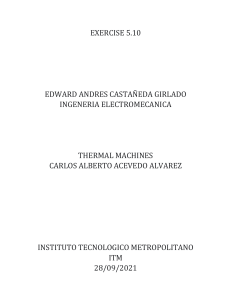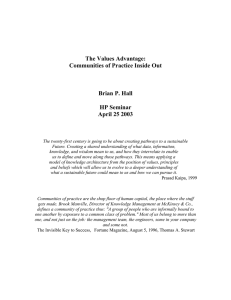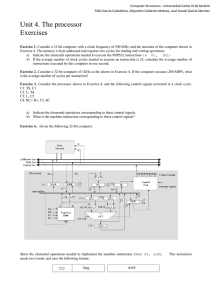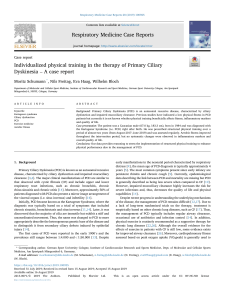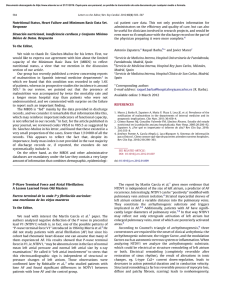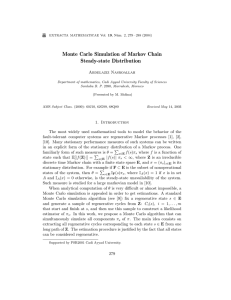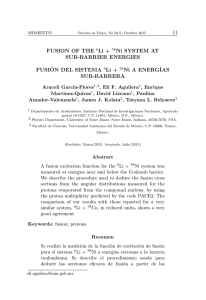EJEMPLO Artículo de comparación de 2 modelos de periodización
Anuncio
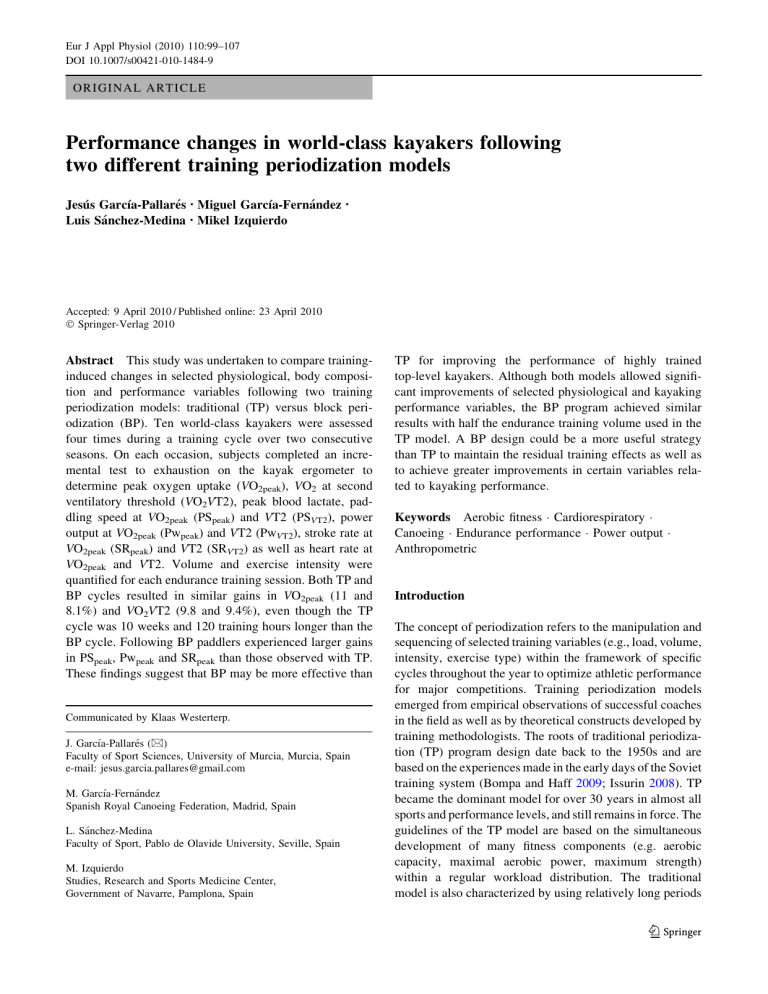
Eur J Appl Physiol (2010) 110:99–107 DOI 10.1007/s00421-010-1484-9 ORIGINAL ARTICLE Performance changes in world-class kayakers following two different training periodization models Jesús Garcı́a-Pallarés • Miguel Garcı́a-Fernández Luis Sánchez-Medina • Mikel Izquierdo • Accepted: 9 April 2010 / Published online: 23 April 2010 Ó Springer-Verlag 2010 Abstract This study was undertaken to compare traininginduced changes in selected physiological, body composition and performance variables following two training periodization models: traditional (TP) versus block periodization (BP). Ten world-class kayakers were assessed four times during a training cycle over two consecutive seasons. On each occasion, subjects completed an incremental test to exhaustion on the kayak ergometer to determine peak oxygen uptake (VO2peak), VO2 at second ventilatory threshold (VO2VT2), peak blood lactate, paddling speed at VO2peak (PSpeak) and VT2 (PSVT2), power output at VO2peak (Pwpeak) and VT2 (PwVT2), stroke rate at VO2peak (SRpeak) and VT2 (SRVT2) as well as heart rate at VO2peak and VT2. Volume and exercise intensity were quantified for each endurance training session. Both TP and BP cycles resulted in similar gains in VO2peak (11 and 8.1%) and VO2VT2 (9.8 and 9.4%), even though the TP cycle was 10 weeks and 120 training hours longer than the BP cycle. Following BP paddlers experienced larger gains in PSpeak, Pwpeak and SRpeak than those observed with TP. These findings suggest that BP may be more effective than Communicated by Klaas Westerterp. J. Garcı́a-Pallarés (&) Faculty of Sport Sciences, University of Murcia, Murcia, Spain e-mail: [email protected] M. Garcı́a-Fernández Spanish Royal Canoeing Federation, Madrid, Spain L. Sánchez-Medina Faculty of Sport, Pablo de Olavide University, Seville, Spain M. Izquierdo Studies, Research and Sports Medicine Center, Government of Navarre, Pamplona, Spain TP for improving the performance of highly trained top-level kayakers. Although both models allowed significant improvements of selected physiological and kayaking performance variables, the BP program achieved similar results with half the endurance training volume used in the TP model. A BP design could be a more useful strategy than TP to maintain the residual training effects as well as to achieve greater improvements in certain variables related to kayaking performance. Keywords Aerobic fitness Cardiorespiratory Canoeing Endurance performance Power output Anthropometric Introduction The concept of periodization refers to the manipulation and sequencing of selected training variables (e.g., load, volume, intensity, exercise type) within the framework of specific cycles throughout the year to optimize athletic performance for major competitions. Training periodization models emerged from empirical observations of successful coaches in the field as well as by theoretical constructs developed by training methodologists. The roots of traditional periodization (TP) program design date back to the 1950s and are based on the experiences made in the early days of the Soviet training system (Bompa and Haff 2009; Issurin 2008). TP became the dominant model for over 30 years in almost all sports and performance levels, and still remains in force. The guidelines of the TP model are based on the simultaneous development of many fitness components (e.g. aerobic capacity, maximal aerobic power, maximum strength) within a regular workload distribution. The traditional model is also characterized by using relatively long periods 123 100 of time for the development of training goals and the predominance of general over specific training. In the 1980s, prominent coaches outlined a number of drawbacks of TP that could prevent elite athletes to achieve further performance improvements: (1) conflicting or negative interactions due to the simultaneous development of too many different motor abilities; (2) failure to provide sufficient workload specificity to enable the correct development of selected fitness components; (3) inability to provide multi-peak performances (4–6 peaks within a season) due to the excessive duration of the different training phases; and (4) difficulty for maintaining the residual training effects of previously developed abilities up to the peaking phase (Issurin 2008). The ever-increasing number of competitions and rigorous demands of modern sport at the elite level, together with the aforementioned limitations of the TP model, led to the emergence of a new planning approach called block periodization (BP). The main feature of this model is the use of highly concentrated training loads focused on the consecutive development of a minimal number of motor and technical abilities (Bondarchuk 1988; Issurin 2008). Specialized training cycles called blocks, with a typical duration of 2–6 weeks, are the main functional components of BP. The sequencing of these blocks is intended to build upon the residual training effects of previously developed abilities. However, despite its widespread use in coaching practice and the extensive lay literature that is available on these periodization models, to the best of our knowledge, there are no published scientific studies that have explored their effectiveness when applied to highly trained subjects. Therefore, the aim of this study was to compare the effects of these two different models (i.e. TP vs. BP) on selected physiological and performance variables in world-class kayakers. It was hypothesized that a BP approach could be more effective than TP for improving elite kayaking performance. Methods Subjects Ten male, elite flatwater kayak paddlers (all finalists at World Championships, including 2 Olympic gold medallists) volunteered to take part in this study. Mean (SD) characteristics of participants were as follows: age 25.6 (2.5) years; height 184.0 (5.9) cm; body mass 85.3 (5.6) kg; training experience 11.2 (2.7) years; annual paddling volume 4,415 (374) km. Paddlers had at least 3 years of familiarization with the testing procedures used in this investigation and all were part of the same squad (i.e. Spanish Canoeing National Team). The study, which 123 Eur J Appl Physiol (2010) 110:99–107 complied with the Declaration of Helsinki, was approved by the Bioethics Commission of the University of Seville, and written informed consent was obtained from athletes prior to participation. Experimental design and approach to the problem A crossover design was used. During the intervention period, all athletes performed the same training program over two consecutive seasons [Season 1 (S1): 2006/2007; Season 2 (S2): 2007/2008]. In S1, paddlers underwent a training program based on the TP model, whereas a BP model was used in S2. The main goal of S1 was the Flatwater Racing World Championships (August 2007), a qualifying event for the Olympic Games. The main goals for S2 were the European Championships in May 2008 (last Olympics qualifier) and the Beijing Olympic Games in August 2008. This investigation was part of a larger project examining selected physiological and performance variables in world-class kayakers following different training phases (Garcı́a-Pallarés et al. 2009a). Figure 1 shows a summary of the training periodization structure used in the present study. Only the first training cycle of each season was analyzed. Both TP (22-week) and BP (12-week) cycles were divided into three phases (ATP, BTP, CTP and ABP, BBP, CBP, respectively). The main endurance training targets for each phase are also shown in Fig. 1. Both ‘A’ phases (12 weeks for TP; 5 weeks for BP) focused on developing basic fitness components, such as second ventilatory threshold (VT2), muscle hypertrophy and general technical abilities. ‘B’ phases (6 weeks for TP; 5 weeks for BP) involved increasing event-specific fitness, such us maximal aerobic power (VO2max) and maximal muscle strength. Finally, ‘C’ phases (4 weeks for TP; 2 weeks for BP) were tapering phases of gradually reduced training volume destined to facilitate the recovery processes, improve specific race-pace strategy and maximize performance for competition. The main differences between both cycles (TP and BP) were the total training volume performed, as well as the percentage of that volume devoted to develop main endurance training targets (VT2 and VO2max). The relative and absolute training time performed in each cycle and phase within each intensity training zone are shown in Fig. 2 and Table 1, respectively. For endurance training sessions, three training zones were identified according to the exercise intensity: zone 1 (Z1), light intensity, below VT2; zone 2 (Z2), moderate intensity, between VT2 and 90% of VO2peak; and zone 3 (Z3), high intensity, between 90 and 100% of VO2peak. When expressed in relative terms, training time in Z2 and Z3 zones during ABP and BBP was around 10% higher than during ATP and BTP. During CBP, paddlers completed half the total training volume than Eur J Appl Physiol (2010) 110:99–107 101 Fig. 1 Study design. Summary of training plan, main training targets and testing calendar for both cycles produced by different types of training programs. With the aim of simplifying the terminology, the term ‘cycle’ used in the present study is proposed to delimit periods of time (8–26 weeks) during which all technical and motor abilities needed to ensure success in competition are developed. It matches up well with the ‘macrocycle’ term usually used in TP and BP. The term ‘phase’ is used to delimit shorter temporal intervals (2–6 weeks) during which a number of selected training targets are developed. Thus, ‘phase’ would match up with the terms of ‘mesocycle’ or ‘period’ of the TP model, and with the terms ‘mesocycle’ or ‘block’ of the BP model. Training intervention Fig. 2 Relative contribution of each exercise intensity zone to the total endurance training volume performed in each phase and cycle. Zone 1: light intensity, below VT2, zone 2: moderate intensity, between VT2 and 90% of VO2peak, zone 3: high intensity, between 90 and 100% of VO2peak during the CTP phase, but the relative contribution over the different training zones was very similar in both tapering phases. The terminology commonly used in training periodization is often inaccurate, obscure and unnecessarily complex making it difficult for coaches and sport scientists to effectively communicate their findings and the effects Before entering both training cycles, participants completed a similar 5-week transition period during which no specific paddling or resistance training were undertaken. Only some recreational physical activities (sport games plus cycling or swimming at low intensities) were performed. A description of the endurance exercise modes used for training in each intensity zone is shown in Table 2. Training volume and intensity were carefully controlled and quantified by experienced canoeing coaches during each training session throughout both cycles. The main variables used for endurance training monitoring were time Table 1 Contribution of each exercise intensity zone to the total endurance training time performed in each phase and cycle A phase ATP B phase ABP BTP C phase BBP CTP CBP Z1 60.7 ± 3.1 17.4 ± 0.8 20.6 ± 0.9 11.9 ± 0.5 9.2 ± 0.3 5.0 ± 0.2 Z2 64.8 ± 2.8 30.0 ± 1.2 27.0 ± 0.9 15.8 ± 0.3 11.1 ± 0.3 4.8 ± 0.1 Z3 9.5 ± 0.5 5.3 ± 0.9 23.4 ± 1.1 21.8 ± 1.0 16.7 ± 0.9 8.6 ± 0.8 Data are expressed in hours as mean ± SD ATP, BTP and CTP: A, B and C phases of traditional periodization cycle ABP, BBP and CBP: A, B and C phases of block periodization cycle Z1: light intensity (below VT2), Z2: moderate intensity (between VT2 and 90% of VO2peak), Z3: high intensity (between 90 and 100% of VO2peak) 123 102 Eur J Appl Physiol (2010) 110:99–107 Table 2 Description of the endurance training modes used for each intensity zone Intensity zone Total volume (min) Z1 Z2 Z3 Rest period (min) Intensity (%VO2peak) Sets Repetitions Work period (min) 70–120 1 1–3 20–90 1–3 70–80 40–90 2–4 1–10 5–20 1–4 80–90 20–60 2–5 4–8 1–8 2–8 90–100 spent (hours) and distance covered (km) for volume; and heart rate and paddling speed for intensity. Distance and speed were registered by means of a GPS receiver (Garmin 201, Garmin Ltd., USA), and heart rate was monitored using standard HR telemetry (S610i, Polar Electro Oy, Finland). In addition to endurance training, subjects took part in a concurrent resistance training program during both TP and BP cycles. Athletes performed three strength training sessions per week, consisting mainly of free-weights exercises (including bench press, prone bench pull, pull-ups, full squat and shoulder press). Strength training during both cycles was structured into cycles of 12–17 weeks, during which three types of strength training were sequentially applied: hypertrophy (8–10 repetitions, 4–5 sets, 70–75% 1RM loading intensity, 2-min inter-set rests); maximal strength (3–4 repetitions, 3–4 sets, 85–90% 1RM, 4-min inter-set rests); and maximal power (5–8 repetitions, 4–5 sets, 45–60% 1RM, 4-min inter-set rests). Strength training volume during the 22-week of the TP cycle amounted to 29.5 ± 1.9 h for hypertrophy; 18.2 ± 1.3 h for maximal strength; and 10.4 ± 1.3 h for maximal power. During the 12 weeks of the BP cycle, strength training volume amounted to 16.9 ± 1.0 h for hypertrophy; 12.5 ± 1.3 h for maximal strength; and 6.8 ± 1.3 h for maximal power. variables showed reliability coefficients ranging from 0.92 to 0.98. The coefficients of variation (CV) for VO2peak, VT2, and HRpeak ranged between 3.2 and 5.1%. The test– retest intraclass correlation coefficients for all variables used in this study were greater than 0.93 and CV ranged from 0.9 to 2.9%. Testing After a 5-min warm-up at a speed of 9 km h-1, subjects completed an incremental paddling test to volitional exhaustion on a kayak ergometer (Dansprint ApS, Denmark; drag resistance coefficient = 35). The first stage was set at a speed of 11.5 km h-1 and the speed increments were 0.5 km h-1 each minute. Each kayaker was allowed to freely adjust his stroke rate (SR) as needed, while this rate was continuously recorded by means of a stroke counter (Interval 2000, Nielsen-Kellerman, USA). Heart rate (HR) was monitored using standard telemetry (S610i; Polar Electro Oy, Finland) and recorded every 5 s. Paddlers were encouraged to give a maximal effort and to complete as many stages as possible. The test concluded when a subject voluntarily stopped paddling or he was unable to maintain the imposed speed. Breath-by-breath gas analysis was conducted throughout using an automated Jaeger Oxycon Pro system (Erich Jaeger, Germany). The gas analyzers were calibrated using a 4.95% CO2–95.05% N2 Kayakers were already familiarized with the testing protocols as they had been assessed on several occasions in previous seasons for training prescription purposes. To assess the selected physiological, performance and anthropometric variables, subjects reported to the laboratory four times during both TP (TTP0, TTP1, TTP2 and TTP3) and BP (TBP0, TBP1, TBP2 and TBP3) cycles. Testing sessions were performed PRE- and POST- the corresponding training phases of TP and BP cycles (i.e. right after A, B and C phases) (Fig. 1). No strenuous exercise was undertaken 24 h before reporting to the laboratory for testing. The same warm-up procedures and protocol for each type of test were repeated in subsequent occasions. All testing sessions were performed at the same time of day (9–12 h) and under similar environmental conditions (20–22°C and 55–65% humidity). Paddling testing 123 Body composition Anthropometric measurements included: standing height, body mass, skinfold thicknesses (triceps brachii, subscapular, suprailiac, abdominal, anterior thigh, medial calf, supraspinale and biceps brachii), and were performed by the same experienced investigator in accordance with the guidelines from the International Society for the Advancement of Kineanthropometry (ISAK) (MarfellJones et al. 2006). Height was measured to the nearest 0.1 cm during a maximal inhalation, and body mass to the nearest 0.1 kg using a calibrated scale (Seca 714, Hamburg, Germany); skinfold thickness was assessed using a skinfold caliper (accurate to 0.2 mm), all from the Harpenden range of anthropometric instruments (Holtain Ltd., UK). Maximal incremental exercise test Eur J Appl Physiol (2010) 110:99–107 103 gas mixture (BOC Gases, Surrey, UK), and the volume sensor using a 3-L calibration syringe. Physiological variables VO2peak was defined as the average of the two highest single consecutive 15-s VO2 mean values attained toward the end of the test. All subjects fulfilled the following two criteria for VO2peak achievement: (1) respiratory exchange ratio greater than 1.1; and (2) peak HR at least equal to 90% of the age-predicted maximum. Second ventilatory threshold (VT2) was determined from gas exchange measurements using the criteria of an increase in both venti-1 latory equivalents (VEVO-1 2 and VEVCO2 ) and a decrease in the end-tidal carbon dioxide tension (PETCO2). Two independent and experienced observers made VT2 determinations. If there was disagreement between the two, a third observer was brought in. HR at VO2peak (HRpeak), and HR at VT2 (HRVT2) were also determined for each paddler. Capillary whole blood samples were taken from each kayaker’s earlobe during test recovery (min 1, 3, 5, 7, 10 and 12) to determine peak lactate concentration ([La-]peak) using a miniphotometer (LP20; Dr. Lange, France). not confirmed, Mann–Whitney U and t test were used to evaluate changes in selected variables over the two cycles. Friedman was applied to evaluate changes in the four tests and in the two cycles. Wilcoxon post hoc corrected the significance level according to Bonferroni. Effect sizes (ES) for changes in both training models (TP and BP) between T0 and T1, T1 and T2, T2 and T3 as well as between T0 and T3 time points were calculated as the difference between the means divided by the average standard deviation for the two groups. Significance was accepted at P B 0.05 level. Statistical power calculations for this study ranged from 0.75 to 0.81. Results At baseline of S1 and S2 (i.e. TTP0 and TBP0), no significant differences were observed for any of the following variables: VO2peak, VO2VT2, [La-]peak, HRpeak, HRVT2, PSpeak, PSVT2, Pwpeak, PwVT2, SRpeak, SRVT2, body mass and sum of eight skinfolds. Body composition Kayaking performance variables Paddling variables that play a key role in kayaking performance were measured during the maximal exercise test: paddling speed at VO2peak (PSpeak), paddling speed at VT2 (PSVT2), stroke rate at VO2peak (SRpeak), stroke rate at VT2 (SRVT2), paddling power at VO2peak (Pwpeak), and paddling power at VT2 (PwVT2). Statistical analyses The Shapiro–Wilk test was applied to determine the nature of the data distribution. Because normal distribution was Between T0 and T3, significant group 9 time interaction was observed for sum of eight skinfolds, with a significantly larger (P \ 0.05) magnitude of decline for TP (-17.9%, P \ 0.05, ES = -2.98) as compared to BP (-5.4%, P \ 0.05, ES = 2.64). Significant declines (P \ 0.05) in sum of eight skinfolds were detected after ATP (-18.1%, ES = -3.07) and BBP (-16.8%, ES = -2.59), as well as significant increases (P \ 0.05) following CTP (9.3%, ES = 1.10) and CBP (21.2%, ES = 2.65) phases. No significant changes were detected in body mass at any time point during both cycles (Table 3). Table 3 Changes in anthropometric variables during the two training cycles TP cycle TTP0 BP cycle TTP1 TTP2 TTP3 TBP0 TBP1 TPB2 TBP3 Body mass (kg) 86.5 ± 4.4 87.1 ± 3.9 86.0 ± 3.7 86.2 ± 4.0 85.7 ± 4.4 87.7 ± 4.8 85.4 ± 4.5 85.2 ± 4.6 Sum 8 skinfolds (mm) 71.4 ± 4.1 58.5 ± 4.3* 53.6 ± 4.6 58.6 ± 4.5£ 67.1 ± 5.1 63.0 ± 4.3 52.4 ± 3.9# 63.5 ± 4.5£b Data are mean ± SD Skinfolds: triceps brachii, subscapular, suprailiac, abdominal, anterior thigh, medial calf, supraspinale and biceps brachii * P \ 0.05 when comparing TTP0 to TTP1 and TBP0 to TBP1 # P \ 0.05 when comparing TTP1 to TTP2 and TBP1 to TBP2 £ P \ 0.05 when comparing TTP2 to TTP3 and TBP2 to TBP3 P \ 0.05 when comparing TTP0 to TTP3 and TBP0 to TBP3 b P \ 0.05 when comparing TTP3 to TBP3 123 104 Physiological changes Both TP and BP cycles resulted in similar gains in VO2peak (11.0%, ES = 2.09 and 8.1%, ES = 2.30, respectively, P \ 0.05) and VO2VT2 (9.8%, ES = 1.79 and 9.4%, ES = 2.00, respectively P \ 0.05). Significant increases in VO2peak were detected from TTP0 to TTP1 (4.9%, P \ 0.05, ES = 1.15), whereas lower, non-significant, increases were observed between TBP0 and TBP1 (3.4%; P = 0.08, ES = 0.86). Following BTP and BBP phases, VO2peak increased significantly in both cycles (7.0%, ES = 1.58 and 5.0%, ES = 1.25, respectively, P \ 0.05). No significant changes in VO2peak were detected between T2 and T3 in any group. The magnitude of changes in VO2VT2 was similar after ATP (15.3%, P \ 0.05, ES = 2.89) and ABP phases (10.7%, P \ 0.05, ES = 2.57). In addition, significant declines in VO2VT2 were observed after BBP (-3.9%, P \ 0.05, ES = -0.69) and BTP phases (-3.4%, P = 0.06, ES = -0.98). No significant changes were detected after CTP and CBP phases in VO2VT2 values. At T3, no significant differences were detected in VT2 (%VO2peak) values between both training cycles. The magnitude of changes in VT2 (%VO2peak) was similar after ATP (9.9%, P \ 0.05, ES = 4.37) and ABP (8.0%, P \ 0.05, ES = 2.1) phases, as well as following both BTP (-9.7%, P \ 0.05, ES = -2.74) and BBP phases (-8.5%, P \ 0.05, ES = -2.96). Kayaking performance changes Significant increases (P \ 0.05) in PSpeak values were detected following ATP (2.1%, ES = 1.00), ABP (2.1%, ES = 1.00) and CBP phases (2.0%, ES = 0.86), whereas lower increases were found after the BBP phase (2.0%, P = 0.06, ES = 0.86). Between T0 and T3, significant group 9 time interaction was observed for PSpeak, with a significantly larger (P \ 0.05) magnitude of increase for the BP (6.2%, ES = 3.00) as compared to the TP (3.4%, ES = 1.25) cycle. The magnitude of increase in PSVT2 between T0 and T3 was similar after TP (5.2%, P \ 0.05, ES = 2.80) and BP (4.4%, P \ 0.05, ES = 2.40) cycles. Significant increases (P \ 0.05) were observed in PSVT2 after both ATP (2.2%, ES = 1.00) and ABP (2.2%, ES = 1.50) phases, whereas it remained unchanged after the B and C phases of both cycles. Between T0 and T3, significant group 9 time interaction was observed in Pwpeak, with a significantly larger (P \ 0.05) magnitude of increase for BP (14.2%, ES = 6.00) compared to TP (8.3%, ES = 4.00). Significant increases (P \ 0.05) in Pwpeak values were detected following ATP (5.0%, ES = 2.31), ABP (6.8%, ES = 1.27), and CBP phases (5.5%, ES = 2.8). The magnitude of increase in PwVT2 between T0 and T3 was similar after TP 123 Eur J Appl Physiol (2010) 110:99–107 (11.3%, P \ 0.05, ES = 4.67) and BP (10.0%, P \ 0.05, ES = 3.80). Significant increases (P \ 0.05) in PwVT2 were detected following ATP (5.3%, ES = 2.22) and ABP (5.8%, ES = 1.69) phases. At T3, SRpeak showed significantly (P \ 0.05) lower values for the BP as compared to the TP cycle. SRpeak increased significantly (P \ 0.05) after the CTP phase (5.9%, ES = 0.92), whereas it remained unchanged after CBP. No other significant differences at any time point were observed for the rest of the physiological and performance variables analyzed (HRpeak, HRVT2, SRVT2, and [La-]peak), although certain trends towards lower values of HRVT2, SRpeak and SRVT2 after both ATP and ABP phases (P \ 0.1) were found (Table 4). Discussion The main finding of the present study was that a block periodized (BP) training cycle seemed to be more effective than traditional periodization (TP) for improving the performance of highly trained top-level kayakers because: (1) both TP and BP cycles resulted in similar gains in VO2peak and VO2VT2, even though the TP cycle was 10 weeks and 120 h longer than the BP cycle; and (2) training-induced increases in PSpeak and Pwpeak (i.e., specific paddling performance) were significantly greater following BP as compared to TP. The most important differences between both cycles were the total training volume (i.e. endurance training hours) and the percentage of training volume developed over the selected endurance training targets. During both initial ‘A’ phases, the main goal was to increase the exercise intensity corresponding to the VT2, whereas during ‘B’ phases, the objective was to improve maximal aerobic power (VO2max) (Fig. 1). Our data indicate that during the BP design paddlers completed a greater workload accumulation over the selected training targets while performing a lower total training volume per intensity zone and per phase than during the TP approach (Table 1). An important finding of the present study was that although the total endurance training time completed in the BP cycle was 50% of that performed in the TP cycle, similar training-induced effects in most of the physiological and performance variables studied were found. VO2peak levels significantly increased following ATP and ABP phases (4.9 and 3.5%, respectively), even though the development of VO2max was not the main goal during these phases and training intensity was kept relatively low (Z1 and Z2 zones). These improvements in VO2peak were likely due to the relatively low initial endurance level exhibited by the athletes as a consequence of the previous 5-week transition period. A decrease in maximal aerobic power after several Eur J Appl Physiol (2010) 110:99–107 105 Table 4 Changes in selected physiological and kayaking performance variables during the two training cycles Traditional periodization cycle VO2peak (mL kg-1 min-1) -1 VO2VT2 (mL kg -1 min ) VT2 (%VO2peak) -1 PSpeak (km h ) -1 TTP0 TTP1 61.1 ± 2.7 64.1 ± 2.5* 50.8 ± 2.4 58.6 ± 3.0 * 83.1 ± 1.1 91.4 ± 2.7* 14.5 ± 0.3 14.8 ± 0.3 * * PSVT2 (km h ) 13.5 ± 0.2 13.8 ± 0.4 Pwpeak (W) 220 ± 5 231 ± 7* PwVT2 (W) [La-]peak (mmol L-1) 186 ± 4 11.5 ± 4.9 * 196 ± 5 11.9 ± 3.2 Block periodization cycle TTP2 TTP3 TBP0 TBP1 68.6 ± 3.2# 67.8 ± 3.7 62.0 ± 2.2 64.1 ± 2.7 TPB2 TBP3 67.3 ± 2.4# 68.1 ± 3.1 * 53.9 ± 2.2# 54.9 ± 2.4 80.1 ± 2.2# 80.6 ± 3.0 56.6 ± 2.8 55.1 ± 2.4 50.2 ± 2.3 56.1 ± 2.3 82.5 ± 3.8# 81.3 ± 1.7 81.0 ± 3.4 87.5 ± 2.8* 14.5 ± 0.3 14.8 ± 0.3 * 15.1 ± 0.4 15.4 ± 0.3£ * 14.1 ± 0.2 14.2 ± 0.3 240 ± 4 254 ± 6£ 207 ± 4 12.7 ± 3.4 210 ± 4 12.0 ± 2.6 15.0 ± 0.3 15.0 ± 0.5 14.1 ± 0.2 14.2 ± 0.3 13.6 ± 0.2 13.9 ± 0.2 237 ± 5 240 ± 5 218 ± 6 233 ± 7* 205 ± 5 10.5 ± 3.5 207 ± 5 11.7 ± 3.1 191 ± 6 11.2 ± 3.7 * 202 ± 7 12.7 ± 3.1 HRpeak (beats min-1) 190 ± 9 187 ± 11 188 ± 9 189 ± 4 193 ± 8 189 ± 7 189 ± 10 189 ± 7 HRVT2 (beats min-1) 176 ± 7 172 ± 8 172 ± 7 176 ± 9 175 ± 6 172 ± 6 171 ± 6 173 ± 7 SRpeak (strokes min-1) 106 ± 4 102 ± 7 102 ± 8 108 ± 5£ 104 ± 4 101 ± 8 102 ± 7 103 ± 8b 86 ± 4 84 ± 3 84 ± 5 87 ± 6 87 ± 5 84 ± 6 86 ± 5 85 ± 6 -1 SRVT2 (strokes min ) b b Data are mean ± SD * P \ 0.05 when comparing TTP0 to TTP1 and TBP0 to TBP1 # P \ 0.05 when comparing TTP1 to TTP2 and TBP1 to TBP2 £ P \ 0.05 when comparing TTP2 to TTP3 and TBP2 to TBP3 P \ 0.05 when comparing TTP0 to TTP3 and TBP0 to TBP3 b P \ 0.05 when comparing TTP3 to TBP3 weeks of training cessation has been reported for endurance athletes (Coyle et al. 1984; Garcı́a-Pallarés et al. 2009b, 2010; Mujika and Padilla 2000). Thus, after resuming formal training, it seems logical that part of the aerobic fitness level was quickly regained, regardless of the training intensities and methods used. Following ‘B’ phases, VO2peak increased by 7.0% in TP and 5.3% in BP, after 33% (23.4 h) and 44% (21.8 h) of total endurance training volume performed in Z3, respectively. In this periodization phase, it should be noted that the BBP was more effective than the BTP phase for the development of VO2max, because paddlers achieved similar performance increases, but using lower training volume. The increases in VO2peak observed in the present study (i.e. 9.5 and 11.0% following the 12-week BP cycle and 22-week TP cycle, respectively) were greater than those previously described for international-level kayakers and canoeists. For instance, Tesch et al. (1976), in a longitudinal study with top-level paddlers, reported increases around 8.0% in VO2max, although these were accomplished after a considerably longer training period (8 months). On the other hand, the training workloads performed by paddlers during both ‘C’ phases were only effective to maintain the VO2peak levels achieved at the end of the previous ‘B’ phases and no further gains were detected. This finding is in agreement with those of Houmard et al. (1994), Shepley et al. (1992) and Van Handel et al. (1988) who observed a stable VO2max following 7–20 days of tapering in highly trained athletes. Furthermore, the lack of further increases in VO2peak after both tapering phases (CTP and CBP) may be related to the high-performance level of the athletes, with VO2peak means of 67.8 and 68.1 mL kg-1 min-1 reached at the end of both training cycles. These VO2peak values were significantly higher than those obtained in other studies with high-level kayakers (mostly in the range of 54–60 mL kg-1 min-1) (Bishop et al. 2002; Fry and Morton 1991; Tesch et al. 1983; Van Someren and Oliver 2002). Significant increases of *15% in VO2VT2 were found following ATP (64.8 h and 48% of total endurance training time in Z2) and ABP (30.0 h and 57% of Z2 training). Since paddlers achieved similar increases in this variable, but using 50% less endurance training volume in Z2, BP seemed to be more effective for developing the VT2 than TP. During BTP and BBP phases, coincident with an important reduction in total endurance training time in Z2 (only 38 and 32%, respectively), VO2VT2 values decreased by 3.4 and 4.3% in the TP and BP cycles, respectively. These data seem to indicate that training volume around the VT2 (Z2) was insufficient, especially during the BP cycle. These results are in agreement with those described by Hickson et al. (1982) who found no changes in VO2max levels and significant declines in time to exhaustion at 80% of VO2max after a 5-week reduction in training volume in well-trained subjects. Furthermore, the duration of the residual training effects seems to be related to factors such as an athlete’s performance level and the amount of training performed on other physical/motor abilities. From 123 106 a practical standpoint, and during either a TP or BP cycle, it would seem adequate to introduce short periods (2–3 days) of high training workload over motor abilities developed in previous phases to maintain their residual training effects. During both ‘C’ phases VO2peak and VT2 levels remained unchanged; thus, both tapering phases prescribed in the present training approach (CTP and CBP) seemed to be effective to maintain the athletes’ performance at VT2 level until the end of the cycle. The similar trends detected in body mass and sum of eight skinfolds following both TP and BP training cycles suggest that these two different periodization designs did not produce different changes in the paddlers’ body composition. It should be noted that following the first two training phases of both cycles (i.e. ‘A’ and ‘B’) body mass remained unchanged while body fat decreased progressively. Sum of eight skinfolds was significantly lower following ATP than ABP, probably as a consequence of the much longer (12 vs. 5 weeks) ‘A’ phase in the TP cycle. Following both ‘C’ phases body mass remained unchanged, but sum of eight skinfolds increased significantly, probably due to the drastic reduction in total training volume and absence of control over the athletes’ diet during this tapering phase. Training-induced changes in kayaking performance variables (PSpeak, PSVT2, Pwpeak and PwVT2) were different following both periodization models. The BP cycle led to significant increases in PSpeak and Pwpeak between the consecutive phases analyzed, whereas the TP cycle showed significant improvements only when the initial and final tests (T0 vs. T3) were compared. Moreover, at the end of both cycles, BP led to significantly better results than those found after TP for PSpeak and Pwpeak (15.4 km h-1 and 254 W in TBP3 vs. 15.0 km h-1 and 240 W in TTP3). Following the BP model, the tapering-related increases of 2% in PSpeak and 4.5% in paddling power at VO2peak were similar to the performance improvements observed in previous studies after tapering phases of 1–4 weeks in highly trained swimmers, cyclists and distance runners (Houmard et al. 1994; Mujika et al. 1996, 2002; Neary et al. 2003). In contrast, the tapering phase of the TP cycle (CTP) only allowed the maintenance of the previously training-induced changes in Pwpeak, together with an increase in SRpeak. These unexpected results after CTP could be related to a loss of the paddlers’ capacity to apply force in each paddling stroke. Thus, an increased stroke rate would be needed to maintain the required paddling power output and/or boat speed. These data are in agreement with a recent study that reported similar increases in stroke rate following 5 weeks of training cessation in toplevel kayakers (Garcı́a-Pallarés et al. 2009b). Therefore, a tapering phase subsequent to a BP cycle may also lead to greater improvements of kayaking performance (i.e. Pwpeak 123 Eur J Appl Physiol (2010) 110:99–107 and SRpeak) as compared to that performed after a TP cycle. Taken together, these data suggest that BP was more effective than TP to avoid the loss of the residual training effects and to achieve a greater kayaking performance peak during the tapering phase in highly trained athletes. Lastly, although it is very difficult to make comparisons of kayaking performance during testing and competition due to the great number of confounding variables that considerably affect split times (e.g. wind speed and direction, water temperature and salinity, depth, currents), it is interesting to note that the results during competitions at the main events of the respective seasons were also very different between cycles. Thus, after the traditional training approach (2006–2007 season), none of the athletes qualified for the Beijing Olympics during the 2007 World Championships. However, during the 2007–2008 season, following a BP training design, four members of the team achieved the qualification for the Olympic Games and, more importantly, a few months later two of them won the Olympic gold medal. In summary, short training phases (5 week) following a BP model using half the total training volume, but with a *10% higher workload accumulation over the selected training targets (45–60% of total training volume) for each phase resulted in a more effective training stimulus for the improvement of kayaking performance when compared with a TP model in elite-level paddlers. The results of the present study also suggest that, following a tapering phase, a BP design could be a more useful strategy to maintain the residual training effects on SRpeak as well as to achieve greater improvements in certain variables related to kayaking performance (i.e. Pwpeak and SRpeak). Acknowledgments We thank personnel from the Andalusian HighPerformance Sports Medicine Centre in Seville and personnel from the High-Performance and Sport Science Research Center (CARICD) in Madrid for their excellent technical help with laboratory apparatus and medical assistance to the athletes. We also acknowledge the dedicated effort, commitment and professionalism of the selected group of kayakers who took part in this research. No funding was received for this work from any institution. Conflict of interest statement The authors declare that they have no conflict of interest relevant to the content of this manuscript. References Bishop D, Bonetti D, Dawson B (2002) The influence of pacing strategy on VO2 and supramaximal kayak performance. Med Sci Sports Exerc 34:1041–1047 Bompa T, Haff G (2009) Periodization: theory and methodology of training. Human Kinetics, Champaign Bondarchuk AP (1988) Constructing a training system. Track Tech 102:3254–3269 Coyle EF, Martin WH, Sinacore DR, Joyner MJ, Hagberg JM, Holloszy JO (1984) Time course of loss of adaptations after Eur J Appl Physiol (2010) 110:99–107 stopping prolonged intense endurance training. J Appl Physiol 57:1857–1864 Fry RW, Morton AR (1991) Physiological and kinanthropometric attributes of elite flatwater kayakists. Med Sci Sports Exerc 23:1297–1301 Garcı́a-Pallarés J, Sánchez-Medina L, Carrasco L, Dı́az A, Izquierdo M (2009a) Endurance and neuromuscular changes in world-class level kayakers during a periodized training cycle. Eur J Appl Physiol 106:629–638 Garcı́a-Pallarés J, Carrasco L, Dı́az A, Sánchez-Medina L (2009b) Post-season detraining effects on physiological and performance parameters in top-level kayakers: comparison of two recovery strategies. J Sports Sci Med 8:622–628 Garcı́a-Pallarés J, Sánchez-Medina L, Pérez CE, Izquierdo-Gabarren M, Izquierdo M (2010) Physiological effects of tapering and detraining in world-class kayakers. Med Sci Sports Exerc. doi: 10.1249/MSS.0b013e3181c9228c Hickson RC, Kanakis C Jr, Davis JR, Moore AM, Rich S (1982) Reduced training duration effects on aerobic power, endurance, and cardiac growth. J Appl Physiol 53:225–229 Houmard JA, Scott BK, Justice CL, Chenier TC (1994) The effects of taper on performance in distance runners. Med Sci Sports Exerc 26:624–631 Issurin V (2008) Block periodization versus traditional training theory: a review. J Sports Med Phys Fitness 48:65–75 Marfell-Jones M, Olds T, Stewart AD, Carter L (2006) International Standards for Anthropometric Assessment. International Society for the Advancement of Kinanthropometry (ISAK). Potchefstroom, South Africa, pp 61–75 107 Mujika I, Padilla S (2000) Detraining: loss of training-induced physiological and performance adaptations. Part I: short term insufficient training stimulus. Sports Med 30:79–87 Mujika I, Busso T, Lacoste L, Barale F, Geyssant A, Chatard JC (1996) Modeled responses to training and taper in competitive swimmers. Med Sci Sports Exerc 28:251–258 Mujika I, Padilla S, Pyne D (2002) Swimming performance changes during the final 3 weeks of training leading to the Sydney 2000 Olympic Games. Int J Sports Med 23:582–587 Neary JP, Bhambhani YN, McKenzie DC (2003) Effects of different stepwise reduction taper protocols on cycling performance. Can J Appl Physiol 28:576–587 Shepley B, MacDougall JD, Cipriano N, Sutton JR, Tarnopolsky MA, Coates G (1992) Physiological effects of tapering in highly trained athletes. J Appl Physiol 72:706–711 Tesch P, Piehl K, Wilson G, Karlsson J (1976) Physiological investigations of Swedish elite canoe competitors. Med Sci Sports 8:214–218 Tesch P, Piehl K, Wilson G, Karlsson J (1983) Physiological characteristics of elite kayak paddlers. Can J Appl Sport Sci 8:87–91 Van Handel PJ, Katz A, Troup JP, Daniels JT, Bradley PW (1988) Oxygen consumption and blood lactic acid response to training and taper. In: Ungerechts VBE, Wilke K, Reischle K (eds) Swimming Science. Human Kinetics, Champaign, IL, pp 269– 275 Van Someren KA, Oliver JE (2002) The efficacy of ergometry determined heart rates for flatwater kayak training. Int J Sports Med 23:28–32 123
